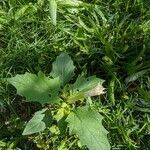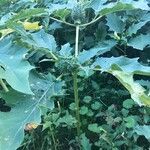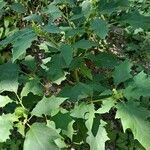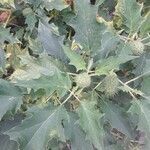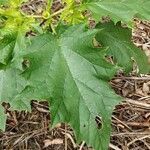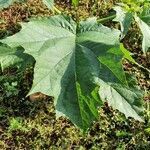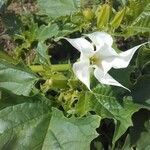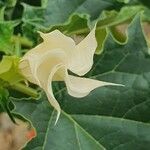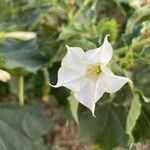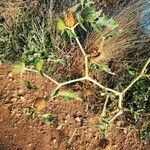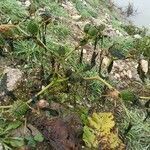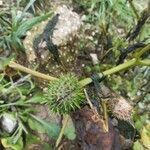Stout annual herb, glabrous or sparsely pubescent with non-glandular hairs. Mature leaves rhomboid to angularly ovate, the lamina up to 36 cm long, deeply lobed, the lobes few and usually coarsely toothed or sinuate. Calyx 3–4 (occasionally to 5.5) cm long, 5-lobed, the lobes 6–8 mm long. Corolla 6–8 (occasionally to 10) cm long, white or pale lavender; limb 5-lobed, the lobes ending in a slender point c. 10 mm long. Stamens not exserted; anthers 3–6 mm long. Style 4–6 mm long; stigma below, level with or above anthers. Capsule ovoid, to 4.5 cm long, erect, spiny; spines 100–200, slender, conical, sharp, variable in length, the longest less than half length of capsule; persistent base of calyx to 10 mm long. Seeds 2.5–4.5 mm long, black or grey.
Foetid annual herb to c. 1 m tall, puberulent, especially when young. Stems usually green or rarely purple. Petiole to c. 7 cm long. Lamina 5-30-(40) × 3-20-(25) cm, narrow-to broad-ovate, lobed; veins remaining puberulent, otherwise lamina becoming glabrous; apex of lobes acute or short-acuminate. Calyx 4-5 cm long, ribbed, reflexing at fruiting; teeth 5-8 mm long, unequal. Corolla 6-8-(9.5) cm long (excluding lobes), usually white or rarely light purple, funnelform; lobes 4-8 mm long, aristate. Fr. 3-5 × 2-3 cm (excluding spines), ovoid, erect, largest towards base of cyme; spines numerous, to 1 cm long, slender, the largest concentrated in upper 1/2. Seeds 2-3 mm wide, reniform, eventually black, irregularly rugose.
Coarse, heavy-scented, inconspicuously puberulent annual to 1.5 m, often divaricately branched; lvs petiolate, with large, coarsely few-toothed or sublobate blade to 2 × 1.5 dm; cal 3–5 cm, strongly prismatic and narrowly 5-winged, unequally 5-toothed, the persistent base 4–6 mm and spreading to reflexed; cor white or anthocyanic, 7–10 cm, the limb 3–5 cm wide, shallowly 5-lobed, each lobe with a slender, projecting tooth to 1 cm; fr erect, ovoid, 3–5 cm, generally covered with short prickles, the lower prickles often shorter than the upper (or the fr smooth); 2n=24. Dry soil and waste places; widespread in temperate and warm regions, perhaps of American origin. June–Aug. (D. tatula, with anthocyanic fls)
Leaves solitary, occasionally geminate; petiole 1–9.5 cm long; lamina membranous or papyraceous, 3.5–20 × 1–15.5 cm, ovate or rhombic-ovate to elliptic or ± oblong to ± lanceolate, base cuneate to ± rounded, truncate or ± cordate, occasionally attenuate, and often dimidiate, sometimes decurrent into the petiole, apex ± acute or acuminate, coarsely and sharply incised-dentate to repand-dentate with irregular, obtuse to acuminate teeth, rarely ± entire, at first minutely pubescent, later sparsely so, more densely towards the base, at or near the margins and on the nerves, to ± glabrous, the lateral nerves extending to the margin.
A stout herb or shrub. It has a rotten smell. it is an annual plant. It is branched and erect and grows 1 m tall. It can have a few hairs. The leaves are deeply lobed. The leaf blade is angular but oval. It is 5-36 cm long by 2-20 cm wide. The lobes have coarse, irregular teeth. The flowers occur singly. They have a stout stalk. It is 0.5-2 cm long. The flower is funnel shaped and white. The tube is 6-8 cm long. There are 5 lobes. The fruit is an oval capsule. It is 3-5 cm long. It has several sharp spines. It opens by 4 valves. The seeds are 2.5-3.5 mm long and black. They have coarse pits. POISONOUS.
Erect, branched, subherbaceous annual, up to 1.5 m high, ± pubescent; bad smell when crushed. Stems striate, pale brown, green or ± purple. Leaves ovate, up to 200 x 200 mm, dark green or purple, paler below, margins sublobed, irregularly dentate; petioles up to 80 mm long. Flowers solitary, axillary on stout peduncles 5 mm long, elongating in fruit. Calyx up to 40 mm long, cylindrical, bases reflexed and enlarged in fruit. Corolla narrowly funnel-shaped, up to 100 mm long, white, mauve or ± purple. Seeds compressed kidney-shaped, 3 mm long, finely pitted, ± brown. Flowering time mostly Oct.-Mar.
Corolla white or faintly tinged purple, sometimes becoming purple or violaceous in the tube, (4)6–10(11) cm long, narrowly tubular-infundibuliform, simple, glabrous or with a few short hairs scattered especially along the longitudinal nerves; tube filling the calyx for ± half or more of its length, with a few minute and short hairs scattered mainly below on the staminal region within; limb (1.5)3–7.5 cm across, 5(6)-lobed; lobes triangular or ovate, narrowing into a long-acuminate tip up to 15 mm long, spreading or recurved.
Annual herb, up to 1.5 m high; robust. Leaves petiolate; blade ovate, up to 200 mm long, margins coarsely and irregularly toothed, veins prominent, upper surface dark green or purple, paler below. Flowers: solitary; pedicels 5 mm long; calyx up to 40 mm long; corolla up to 100 mm long, with 5 prominent teeth on rim, white, mauve or purplish; Oct.-Mar. Fruit an ovoid capsule, up to 50 x 30 mm, covered with slender, spine-like outgrowths of unequal length, up to 10 mm long.
Fruit upright, yellowish to brown when ripe, 2.5–5 × 2–4.5 cm including spines, subglobose or ovoid to ± ellipsoid, thick-walled, densely covered with many, rather slender to occasionally stout, stiff, ascending, subequal or unequal spines up to 16 mm long (rarely unarmed elsewhere), puberulous, less abundantly on the spines, regularly breaking up downwards (and bearing a strikingly developed false dissepiment).
Calyx 2.5–5 × 0.4–1 cm, 5-angled to 5-ribbed, ± puberulent, more densely so towards the base and on the lobes, especially at the margins inside and out, drying with somewhat prominent longitudinal nerves, the tube little or not inflated and slightly wider at the base; lobes unequal, 4–10 × 2–4 mm, triangular to lanceolate, acute to long-acuminate or cuspidate; in fruit the flange up to 13 mm wide, reflexed.
Stamens 5, white or purple, included; filaments adnate to above the middle of the corolla tube, with short, hyaline, occasionally glandular hairs, free upwards for 1.8–3.3 cm and ± glabrous; anthers (4)5–7.5(8) mm long, elliptic or ± oblong in outline.
Erect, usually ± dichotomously branched, annual, biennial or more rarely short-lived perennial herb, sometimes ± bushy, less often a shrub, 0.2–1.5(2) m high, unpleasantly scented, green or tinged purple or violet.
Annual herb, up to 1.5 m high. Pedicels 5 mm long. Calyx 40 mm long. Corolla up to 100 mm long. Fruit over 30 mm in diameter, covered with spreading spines up to 10 mm long. Flowers white, mauve or purplish.
Ovary up to 5 × 4 mm, pyramidal or ovoid, with ± long, fleshy appendages (or smooth outside the Flora Zambesiaca area), puberulent and glandular; style 3.5–6.8(7) cm long, straight, glabrous.
Seeds dark brown to black, 3.5–4.5 × 2.5–3.3(3.5) × 1.2 mm, ± reniform, strongly thickened and alveolate at the border, finely pitted; caruncle very small, fleshy.
Flowers solitary, inserted in the forks of the branches, erect; pedicel 5–15 mm long, slender to ± stout, ± puberulent, in fruit elongating to 30 mm and stout.
Rather slender white (D. stramonium Linn. proper) or purple-violet (D. tatula Linn. proper) flowers. The flower-colour is of no taxonomic importance.
Branches striate and ± sulcate, ± glabrous or with ± sparse hairs, more abundant on the young parts and near the nodes, and often glandular.
Erect branched, annual with smooth stems 1-2 ft. or more high
